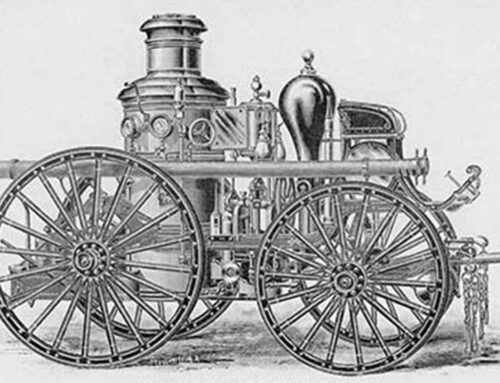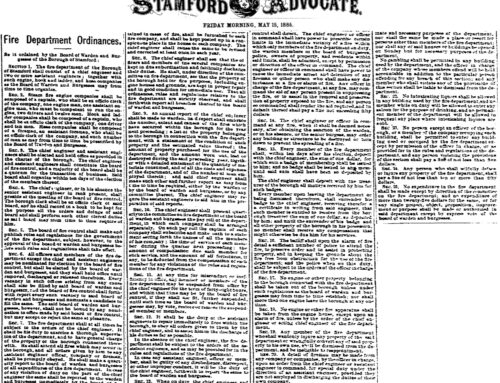
Source: Stamford History Center (edited by Captain Philip Hayes)
At 7:00 in the evening of February 19th, 1919, a small fire started in the acid storage room of the huge Cove Mills, a complex of about 25 “fireproof” buildings sprawled over western Cove Island and well up Cove Road. It rapidly became the most spectacular, most destructive fire in Stamford history. A fire loss, that as the time was valued at over $2,000,000. In 2021 dollars, that would equate to a 34 million dollar loss.
General W.W. Skiddy was the President of the Stamford Manufacturing Company in 1919 when the fire occurred. He became president sometime after he married the daughter of William Gay, the former President of the Corporation.
W.W. Skiddy was a multimillionaire and father of the Yale Rowing team. He obtained his military title of “Commissary-General” in 1883 when he was appointed commissary general of the Connecticut National Guard. The title of General was for William W. Skiddy was more of an honorary one for the same title had been held by his father, Gen. William Skiddy, a prominent naval architect and builder and outstanding participant in the War of 1812.
William W. Skiddy was born in New York on April 26, 1845, but came to Stanford when he was not quite 30. His death occurred on Oct. 27, 1929. At the time he was the oldest living graduate of the Yale Scientific School.
According to the 1901 Sanborn Insurance Map, the factory operated 24 hours a day with 305 employees, fifty of whom work the night shift. There were three-night watchmen, two carrying Buerk watches that had six stations each. Lighting was powered by electricity. The heat was provided by a steam system powered by coal and waste wood. The complex had six 2-1/2″ hydrants with 100 feet of 2-1/2″ cotton hose pre-connected to each hydrant. Around the building were another four 2-1/2″ hydrants. Barrels of water and fire pails could be found in each building. The plant also had two small hose carts with 200′ of 2-1/2″ hose on each that could connect to the 2-1/2″ hydrants. The plant also had traditional and REX Chemical extinguishers. Water was supplied from a large pond about one mile north of the plant. The pond reportedly provided a six-foot head (pressure) at the factory. There were two supply pipes, one 10 inches, the other 8 inches that led from the pond to the factory hydrants. All hydrants in the years and around the buildings were connected to backup steam pumps that could draw salt water from the harbor. A dedicated group of employees regularly practiced their fire duties using one “Hand Engine” (believed to be the ole Rippowam).
About 100 workers were in the plant that the time of the fire. A strong northwest wind spread the flames quickly as firebrands leap-frogged across the giant complex. All the firefighting apparatus from Stamford, Noroton Heights, Glenbrook, and Springdale, the strategic fire hydrants, and the firewalled brick construction proved powerless. The flames lit up the sky with vivid colors, drawing thousands of spectators to the high ground around the plant. The drama was startling as boilers blew up, extract vats popped and massive brick walls tumbled. Fortunately, the terrifying sparks flew mostly toward the Sound, away from nearby homes, though some owners took furniture outside for safety. Firebrands hit General Skiddy’s Pound Rocks mansion and the Holly house, now SoundWaters Inc. HQ, but residents on the roofs and firefighters saved them.
Spectators were most concerned when two barges, loosed from their piers, were blown into the Sound with two women and three men needing rescue.
All major factory buildings, machine shops, laboratories, storage buildings, etc., were destroyed. Among them were three large three-story brick buildings up to 300 ft. long, a metal-clad steel building 200 ft. long, and a large two-story wooden building. Three tall chimneys, one 126 ft. high, stood “like loyal, weary sentinels” over the jumbled kilns and smoldering, twisted rubble. The office building survived, as did a small brick building to the north that still stands.
Started in 1792 as a small tidewater gristmill on the eastern edge of Cove Island, Stamford Manufacturing Co. grew to become Stamford’s largest industry and the world’s largest dye extracting concern. At its peak in 1890 it employed about 500 workers, with state-of-the-art facilities on 70 acres at the Cove, thousands of feet of mechanized wharves hosting big deep-sea schooners, a shipping company with four schooners, and a number of houses on Weed Street.
The mill’s main products were textile dyes extracted from exotic tropical woods, drugs from barks, tanning extracts, and licorice paste used in drugs, brewing, tobacco, and confections. It acquired licorice farms in Asia and Europe. (in 1885, 15 million pounds of licorice root arrived in Bishop’s Cove!) A mill was built in Virginia for yellow dyes. In earlier years, the company had owned a barite mill in New Haven and several barite mines.
Stamford Manufacturing Co. was truly a pioneer in applying science to haphazard processes. In 1832, age-old dyewood dyes were primitive but very popular. Aggressive research in critical areas such as mordants and process techniques gave the company the lead in the accuracy, reliability, and consulting services sorely needed by the booming textile industry.
But in the early 1900s, the company fell behind. Aniline dyes took over in textiles and tanning. Drug extracts and the licorice boom phased out. Reorganized as the Stamford Extract Manufacturing Co., the owners discovered it was more important to own a market than a mill. On February 20th, 1919, they didn’t even own a mill.
Before the Fire
After the Fire
Remnants of the Factory Remain
Stamford Advocate Article

1901 Sanborn Fire Insurance Map



















